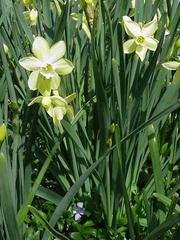
The countryside around my family’s summer cottage in Central New York State is studded with former farm sites. Sometimes buildings or their dilapidated remains are evident on the overgrown lots that were once the hubs of working family farms. More often, all that remains are the horticultural memories of those farms—garden plants once tended by farm families and now surviving on their own. When I think about plants that require little from gardeners and give back beauty and longevity, I remember those long-lost farmsteads.
Among the plants most often holding their own on old sites are daffodils, peonies and lilacs. All can be planted in the fall, so now is the time to think about making the investment.
Daffodils, on sale just about everywhere, stand the test of time. The old-fashioned poeticus or “pheasant eye” types with their small trumpets delighted poet Edna St. Vincent Millay when she bought her New York State property, “Spindletop” in the 1920’s. They bloom there still. I have seen them growing in rocky clay soil at the edge of the woods behind our cottage. They may have been planted by my aunt in the 1940’s but might also have been in place long before she took up a trowel.
Almost any daffodil will hold up well. The original bulbs produce offspring, sometimes called “daughter bulbs” and clumps will increase over time. It’s a good idea to divide large clumps, especially if the plants seem to be producing fewer flowers, but it’s also true that those daffodils thriving on abandoned sites have managed to get along without being divided.
Fragrance is always a factor in my plant choices, especially with plants that I know will be around for a long time. Many daffodils carry some scent, but standouts include the poeticus types that delighted Millay. I especially like the heirloom Narcissus poeticus recurvus, a very old “pheasant eye” type that harkens back to herbals published in the 1600’s. ‘Carlton’, a big yellow trumpet type that often stands in for the hard-to-find ‘King Alfred’, has fragrance as well. For smaller spaces, sweet-smelling little ‘Baby Moon’ is perfect. It is a jonquilla type that stands only ten inches tall, and bears rounded yellow petals.
I think some of the best daffodil fragrance comes from ‘Rose of May’, which smells just as you think it might. It is a gorgeous double variety with sumptuous ivory petals. Unfortunately it is only hardy in USDA plant hardiness zones 4a through 6b, preferring to live in conditions that are neither too hot nor too cold. I have grown it successfully in a protected part of my USDA Zone 7a garden. For fragrance alone it is well worth taking the risk.
Gardeners and others are of divided opinion on paperwhites. Some think they smell delightful while others steer clear of them at all costs. To avoid wrinkled-up noses, opt for the paperwhite-like ‘Ehrlicheer’, a star in the garden and wonderful for winter forcing. Each stem features multiple blooms, a testament to the idea that more is sometimes better.
Old-fashioned garden or herbaceous peonies, know botanically as Paeonia lactiflora, live nearly forever, though they may sulk if you move them. Some varieties have little or no scent, but there are plenty that stand both time and sniff tests. ‘Duchesse de Nemours’ is high, wide and handsome, a white-flowered, rose-form variety that hails back to the nineteenth century. Another old French variety, ‘La Perle’, is pale pink shading to darker pink at the edges and smells of spice. The patriotic-sounding ‘Bunker Hill’ is a deeper shade of rose with an abundance of fragrant petals. The anonymous scented peony that came with my house and has multiplied handily, looks a lot like ‘Bunker Hill’. It is rose-scented.
People are sometimes critical of lilacs because they need pruning to look their best. Still, every old farmhouse used to have a lilac somewhere near the door. The doors and the people that ambled through them may be long gone, but the lilacs still reach for the sun every spring and produce at least a few brave blossoms. At our summer cottage we have two of them, one white and one medium purple. The white-flowered one smells better but both have survived countless storms, droughts, and other calamities to bloom every year.
If you are not fortunate enough to have an old lilac on your property, try ‘President Lincoln’, an antique with blue-purple blooms. Another president–this one French–the double-flowered ‘President Grevy’, combines luxurious flowers with alluring fragrance. ‘Madame Lemoine’, also an heirloom of French origin, is one of the best white lilacs, with double flowers.
If you are looking for the most fragrant lilac varieties, resist the urge to buy one of the modern reblooming lilacs. Whatever their value as landscape plants, they lack the elegance and fragrance of the older, once-blooming types.
If you are troubled by deer or other four-legged plant predators, it pays to remember that daffodils, peonies, and lilacs have flourished while generations of deer passed them by. Combine that with fragrance, beauty and longevity and you have great garden investment plants.
